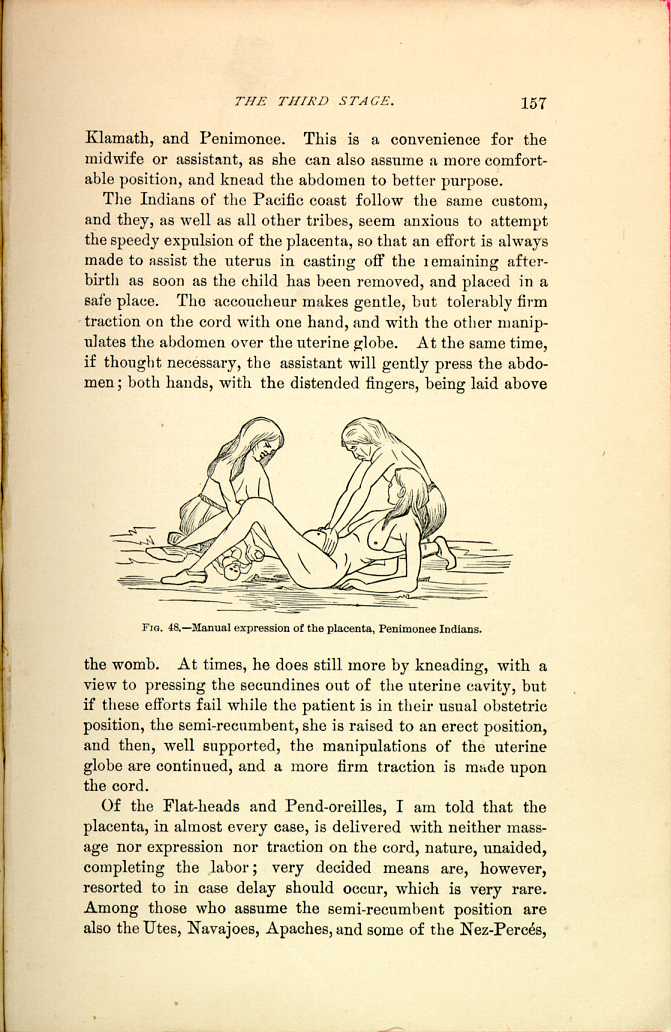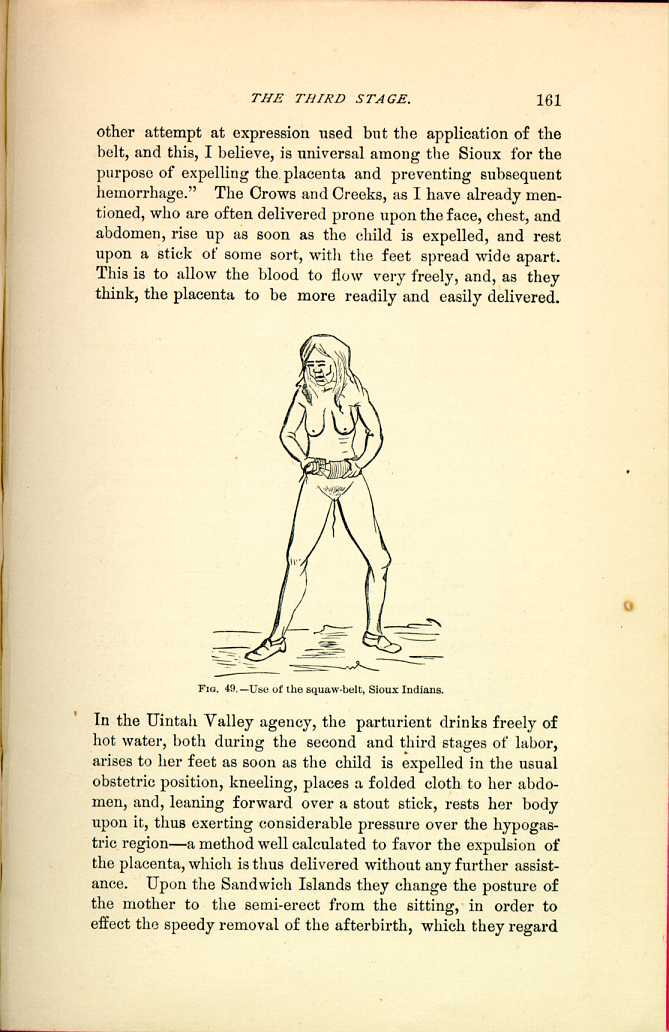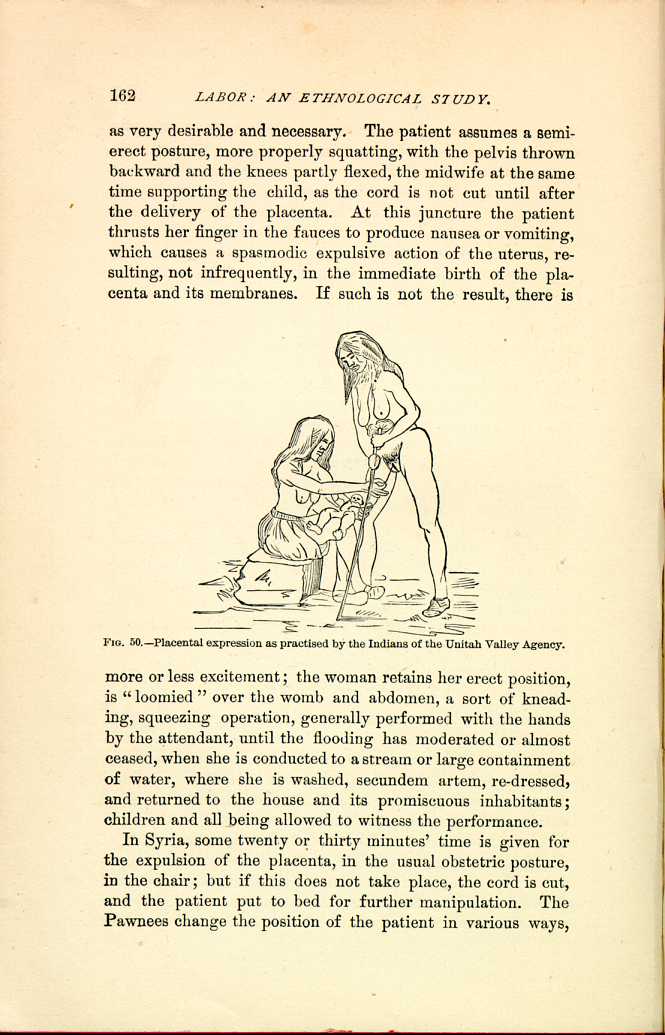| CHAPTER III. THE THIRD STAGE OF
LABOR. Labor Among Primitive Peoples | ||
MANAGEMENT OF SIMPLE CASES.
The placenta delivered in the same position which has been occupied during labor pains and the expulsion of the child.
Manual expression.—Among our Indians, as among all uncivilized nations, external manipulations are resorted to wherever good can be accomplished by them, and in obstetric practice massage and expression are freely and effectively used. The third stage of labor is a very short one, the placenta usually escaping very soon after the birth of the child; and by far the most common, the prevailing treatment in fact, is the one we will now consider. The patient and her assistants retain the positions relatively occupied during the birth of the child; the
The Kootenais kneel during labor, and after expulsion of the child continue to knead the abdomen, exercising the same pressure downward as when aiding the descent of the child, and in case this fails, they introduce the hand into the vagina and remove the placenta, giving the woman one joint of an unknown root to stop the hemorrhage, following it by another joint in fifteen minutes or half an hour until it does stop, with the idea
The women of the lower order of Mexicans, who are also usually delivered in the squatting posture, sometimes kneeling, follow the same custom as their Indian neighbors, but of them I am told that the third stage of labor is a much longer one. The midwife busies herself about the new-born child, while the patient is kept in her uncomfortable position, kneeling or squatting, with her rear and lateral assistants, until the placenta is expelled. This takes place seldom in less than half an hour, but generally within an hour; if not, the patient receives a more or less violent shaking, according to the exigencies of the case, the rear assistant, with her arms about the patient, actually shaking her up and down, and, if this does not answer, as a last resort, efforts are made to provoke vomiting. A decoction of some kind, either laxative or nauseating, is given the patient for the purpose of assisting the expulsion of the placenta; but among the Mexicans a cup of corn gruel, atole, is regularly given after the expulsion of the child. Among those who retain the semi-recumbent position in which they are usually delivered are the Wacos, Hoopas, lower
The Indians of the Pacific coast follow the same custom,
and they, as well as all other tribes, seem anxious to attempt
the speedy expulsion of the placenta, so that an effort is always
made to assist the uterus in casting off the remaining afterbirth
as soon as the child has been removed, and placed in a
safe place. The accoucheur makes gentle, but tolerably firm
traction on the cord with one hand, and with the other manipulates
the abdomen over the uterine globe. At the same time,
if thought necessary, the assistant will gently press the abdomen;
both hands, with the distended fingers, being laid above

FIG. 48.—Manual expression of the placenta, Penimonee
Indians.
[Description: Woman reclines on floor, propped up on her elbows. One
assistant attends the newborn, while a second presses against the
patient's abdomen. Black and white illustration.]
Of the Flat-heads and Pend-oreilles, I am told that the placenta, in almost every case, is delivered with neither massage nor expression nor traction on the cord, nature, unaided, completing the labor; very decided means are, however resorted to in case delay should occur, which is very rare. Among those who assume the semi-recumbent position are also the Utes, Navajoes, Apaches, and some of the Nez-Percés,
The Burmese are among the very few people who adopt a dorsal decubitus as the obstetric position, and forcibly expel the placenta more by beating the abdomen than well-directed manipulations, and in extreme cases, by sitting or standing upon the abdomen and pressing with the feet upon the uterine globe.
The Makahs, of the Neah-Bay agency, retain the sitting posture in which the child is delivered, but whilst this, to them, apparently simple proceeding is always managed without professional assistance of any kind, skilled help is called as soon as the child is born. Until then nature is allowed to take its course, but as soon as the child is expelled, an old woman, who makes this a specialty, is called to deliver the afterbirth, which she does by pressing and working the abdomen constantly until the placenta and the clots are removed. This person has nothing whatsoever to do with the delivery of the child. The same position is occupied by the women of the Skokomish agency, and here, also, the very best practice is followed, the placenta being allowed to come away without any manual interference except expression over the region of the womb and a slight traction on the cord.
The Brulé Sioux and Warm Spring Indians retain the standing posture, in which the child is delivered; the midwife, standing behind the patient, aids the naturally rapid expulsion of the placenta by pressure on the fundus with her hands, varied by a kind of churning manipulation.
Intra-Abdominal Pressure.—The use of the diaphragm as a powerful aid to all efforts to expel the contents of the abdominal cavity is well-known to our midwives, and we know how frequently they direct their patients either to hold their breath or to scream, as the exigencies of the case may demand; but, fortunately, they do not resort to measures quite so violent as our Spanish neighbors in Mexico, who assist the expulsion of the placenta by vomiting the unlucky patient. Some of our Indian tribes also lay stress upon the intra-abdominal pressure, and the assistance of the diaphragm and abdominal muscles,
Traction on the Cord.—Traction upon the umbilical cord appears so natural, and is certainly so tempting a means of removing the placenta, that it is much esteemed by a class of meddlesome midwives which abounds in all civilized countries to the detriment of parturient women, but the untutored savage, guided in his practice by instinct and observation, is too shrewd to seek the removal of the retained placenta by such dangerous means.
Although it is customary, among some of our Indian tribes, to make a certain traction upon the cord, I am uniformly told that this is always done with extreme caution, and but very few make use of it to drag down the afterbirth—a manipulation fraught with so much danger, and unfortunately so common among more intelligent people.
The Crows and Creeks are usually delivered prone upon the stomach, and the placenta is rapidly expelled, either in the same posture or while standing; in rare cases it is delayed, and then it is allowed to remain until it decomposes, and, remarkable to say, pyemia rarely follows, probably on account of the naturally strong constitution of the race. Among them, gentle traction upon the funis is the only assistance accorded to nature, and if there be much resistance, it is at once stopped, and the placenta allowed to remain, in preference to attempting its delivery by stronger traction.
The Rees, Gros-Ventres, and Mandans are confined in a kneeling posture, in which the placenta also is expelled, but if it does not come away rapidly, with some little rubbing of the belly with the hands greased with turtle fat, the accoucheur pulls gently and steadily on the cord, evidently relying somewhat upon this traction for the removal of the placenta.
The worst practice is that of the Cheyennes and Arrapahoes, who retain the dorsal decubitus in which the child is expelled, but never wait for the expulsion of the placenta by the proper contraction of the womb, removing it at once by
A change of position is not infrequently made immediately after the birth of the child, with a view to hastening the expulsion of the after-birth. As this period of labor is a short one, an uncomfortable position, if otherwise advantageous, may be readily assumed; and, moreover, the muscular effort, which the patient involuntarily undergoes in making this change, will assist the contraction of the womb. The change most frequently made is to a standing posture. Thus the squaws of the Cattaranguts rise to their feet from the kneeling posture, which they occupied during the birth of the child, with the idea of facilitating the expulsion of the afterbirth. If this does not take place within a short time, the attendant makes traction on the cord, at the same time making downward pressure over the abdomen, while the parturient maintains the standing posture.
Dr. D. D. Taylor, surgeon U. S. Army, in detailing the labor of a Sioux squaw whom he delivered, seated cross-legged on the floor, says: "The moment I cut the cord she jumped to her feet, and, standing erect, seized the squaw-belt, a leather belt about four inches wide, which she buckled over her hips and abdomen, drawing it as tightly as her strength would permit. During this time the hemorrhage was very abundant; within a minute, however, the placenta dropped on the floor, the bleeding ceased, the womb becoming firmly contracted, and she sat down on a stool looking as if nothing unusual had happened. The belt was removed the next morning, and she remained up and went about the house as usual. I saw no

FIG. 49.—Use of the squaw-belt, Sioux Indians.
[Description: Woman stands with feet apart, holding belt around her abdomen. Black and white illustration.]
FIG. 50.—Placental expression as practiced by the Indians of the Unitah Valley Agency.
[Description: Post-partum woman stands leaning upon a pole, while an attendant, newborn in lap, works to express the placenta. Black and white illustration.]In Syria, some twenty or thirty minutes' time is given for the expulsion of the placenta, in the usual obstetric posture, in the chair; but if this does not take place, the cord is cut, and the patient put to bed for further manipulation. The Pawnees change the position of the patient in various ways,
| CHAPTER III. THE THIRD STAGE OF
LABOR. Labor Among Primitive Peoples | ||